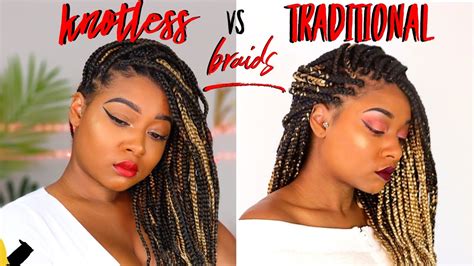Introduction

Braids have been a staple in the African American community for centuries. Recently, two popular braiding techniques have emerged: knotless braids and box braids. Both styles offer versatile, protective hairstyles, but subtle differences set them apart. This comprehensive guide will help you navigate the world of knotless vs. box braids, empowering you to choose the style that best meets your hair goals.
Knotless Braids: A Painless Perfection
Knotless braids, as their name suggests, are created without any knots. The braiding thread is continuously wrapped around the natural hair, creating a seamless, non-restrictive hold. This technique eliminates the tension and scalp discomfort often associated with traditional box braids.
Benefits:
- Minimal scalp tension: The absence of knots reduces strain on the scalp, promoting healthy hair growth.
- Lightweight and comfortable: Knotless braids are less bulky than box braids, making them less prone to tangling and weight-related breakage.
- Suitable for all hair types: Knotless braids can be installed on various textures, including fine, delicate hair.
Box Braids: Structural Strength and Versatile Styling
Box braids are a classic braiding style that involves dividing the hair into square sections and braiding each section individually. This technique creates a sturdy, box-like effect that can withstand everyday wear and tear.
Benefits:
- Exceptional durability: Box braids are known for their longevity, lasting up to 8 weeks with proper care.
- Versatile styling options: Box braids offer endless possibilities for styling, including updos, ponytails, and buns.
- Protective against damage: The tight, interlocking nature of box braids shields natural hair from environmental factors and mechanical damage.
Comparing Knotless and Box Braids
| Feature | Knotless Braids | Box Braids |
|---|---|---|
| Knotting | No knots | Individually knotted |
| Scalp tension | Minimal | Moderate to high |
| Comfort | Lightweight and comfortable | Heavier and potentially uncomfortable |
| Suitability | All hair types | Coarse or thick hair |
| Durability | Moderate | High |
| Styling versatility | Limited | High |
| Protective properties | Good | Excellent |
Which Style is Right for You?
The best braiding style depends on your individual preferences, lifestyle, and hair type.
- If scalp sensitivity and comfort are your top priorities, knotless braids are your ideal choice.
- If you desire maximum durability and styling versatility, box braids are a reliable option.
- If you have fine or fragile hair, knotless braids are more gentle and less likely to cause damage.
Table 1: Comparison of Pain Levels
| Braiding Technique | Pain Level |
|---|---|
| Knotless Braids | Low to moderate |
| Box Braids | Moderate to high |
Table 2: Durability and Longevity
| Braiding Technique | Durability |
|---|---|
| Knotless Braids | Up to 6 weeks |
| Box Braids | Up to 8 weeks |
Table 3: Suitability by Hair Texture
| Hair Texture | Suitable Braiding Technique |
|---|---|
| Fine, delicate hair | Knotless Braids |
| Coarse, thick hair | Knotless or Box Braids |
Table 4: Styling Options
| Braiding Technique | Styling Options |
|---|---|
| Knotless Braids | Limited (e.g., half-up, down) |
| Box Braids | Extensive (e.g., updos, buns, ponytails) |
Conclusion
Knotless and box braids are both versatile and protective braiding styles. Knotless braids offer comfort and minimal scalp tension, while box braids boast durability and styling versatility. Understanding the key differences between these techniques will empower you to make an informed decision that aligns with your hair goals.
Additional Resources
- Knotless Braids: A Step-by-Step Guide
- Box Braids: The Ultimate Guide
- Knotless vs. Box Braids: Which Should You Choose?
